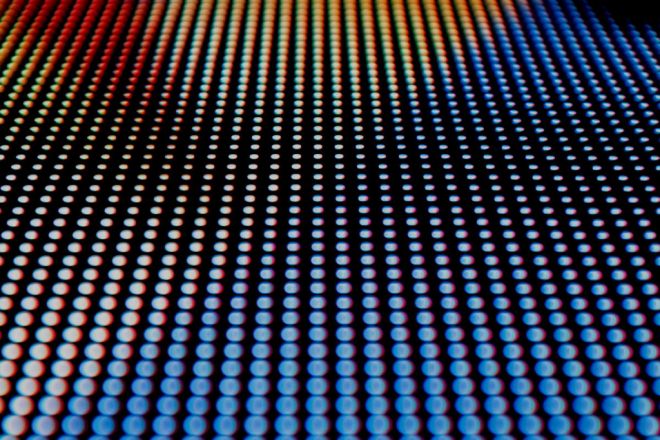Introducción

As people’s requirements for visual experience continue to improve, the display effect of pantallas LED is also facing higher challenges.
Among them, color accuracy is one of the important indicators for measuring the display effect of LED display screens, and its importance has become increasingly prominent. Color accuracy is not only related to the true restoration of the picture but also directly affects the audience’s visual experience and the accurate communication of information.
So, what is the color accuracy of LED display? What is the principle? You will know after reading this article.
1. Basic concepts of LED display color accuracy

- The definition and measurement standard of color accuracy
Color accuracy, simply put, refers to the LED display’s ability to accurately restore the color of the original image when displaying the image. It measures how accurately a display displays colors within the color gamut coverage. For LED displays, color accuracy is one of the important indicators for evaluating its display performance.
The main parameter to measure color accuracy is the △E value. The smaller the △E value, the higher the color accuracy of the display; that is, the closer the displayed color is to the color of the original image. However, it is worth noting that due to limitations in display technology, no display can achieve an absolute color standard, so the △E value can never be equal to 0. In practical applications, what we pursue is the smallest △E value possible to provide more accurate color performance.
- The main influencing factors of LED display color accuracy
The color accuracy of LED displays is affected by many factors. First of all, the manufacturing process and materials of the display screen have a direct impact on color accuracy. High-quality LED chips, precise drive circuits, and advanced display control technology all help improve the display’s color accuracy and performance.
Secondly, environmental factors will also have an impact on color accuracy. For example, the surrounding lighting conditions, the display angle, and the viewing distance may have a certain impact on the color accuracy of the display.
In addition, the quality of the video or image content played is also an important factor affecting color accuracy. If the color of the original image is inaccurate, no matter how excellent the color accuracy of the display is, it will not be able to restore the true color.
- The relationship between color accuracy and visual experience
There is a close connection between color accuracy and visual experience. The high-color-accuracy LED display can more accurately restore the color of the original image, making the picture more realistic and delicate. This not only helps to improve the audience’s visual enjoyment but also better conveys information and enhances the audience’s sense of immersion and involvement.
In some application fields with high color requirements, such as medical imaging, artistic creation, etc., high color accuracy LED displays play an irreplaceable role. It can help doctors diagnose conditions more accurately and help artists better present their creative intentions, thus improving the results of works in related industries.
Therefore, improving the color accuracy performance of LED displays is of great significance to improving the visual experience and promoting the development of related industries.
2. Technical principles of LED display color accuracy
The color accuracy of an LED display, in layman’s terms, refers to how similar the color it presents is to the color of the original image. So, how do you ensure this color accuracy? A series of technologies and principles are involved in this.
First, we have to understand how LED chips emit light. Imagine that the current is like a stream of water. When it flows through the LED chip, it meets the electrons and holes inside the chip. When they meet and hold hands, they release energy, which becomes the light we see.
The color of the LED chip is different because of the different types of materials and doping elements inside it, just like different ingredients make dishes with different flavors.
So, how does the LED display screen display rich and colorful colors? In fact, it’s like a colorist mixing colors. There are three types of LED chips in the display: red, green, and blue. By adjusting their brightness ratio, just like a colorist mixing different colors of paint, we can get the color we want.
But LED chips alone are not enough. A “big housekeeper” is also needed to manage them, and that is the driver circuit. The driver circuit is like a power supply that supplies power to LED chips, ensuring that they can emit light stably.
If the drive circuit is not designed well, the LED chip may have problems such as uneven brightness and color deviation. Just like a stage with unstable lighting, the actor’s performance will also be affected.
In order to display colors more accurately, we have to use some “black technology.” For example, accurately control the current or voltage to make the LED chip emit light more stably.
Select high-quality electronic components to reduce interference in the circuit; and consider the impact of temperature changes on the circuit and perform temperature compensation, just like in summer. It’s the same as adding water to the car to cool it down.
In addition to hardware-level optimization, display control technology also plays an important role. It is like a senior colorist, making fine color adjustments for each pixel on the display to eliminate color deviations caused by manufacturing processes, drive circuits, and other factors.
Finally, don’t forget the “general director” of the color management system. It is responsible for processing color data throughout the display process to ensure color accuracy and consistency.
With the continuous advancement of technology, modern color management systems are becoming more and more advanced, just like movie directors use high-tech means to improve the quality of the picture, making the colors we see more real and vivid.
3. Technical means to improve the color accuracy of LED displays

- High-precision calibration methods and equipment
High-precision calibration, simply put, is to accurately adjust the color and brightness of the LED display to ensure that the picture it displays is accurate in color and uniform in brightness. To achieve this goal, we need to use some professional calibration methods and equipment.
First, let’s talk about ambient light control. Imagine if you are watching TV during the day and the sunlight outside the window is very bright; the color of the picture on the TV screen may be affected and not appear as vivid or accurate.
Likewise, LED displays are also affected by ambient lighting. Therefore, before performing calibration, we need to ensure that the light intensity around the display is moderate by adjusting curtains or using a blackout cloth so that the calibration results will be more accurate.
Next is the brightness adjustment. The brightness of the LED display can be adjusted, but how can it be adjusted to the most appropriate state? This needs to be carried out according to the characteristics of the display content and the requirements of the display environment.
For example, if some dark-toned images are displayed, we need to lower the brightness appropriately to prevent the image from appearing too dazzling; conversely, if bright and colorful images are displayed, we need to increase the brightness to make the image more vivid.
In addition to brightness, the flatness of the display screen also affects picture quality. If the surface of the display screen is uneven, uneven brightness distribution may occur, resulting in “bright spots” or “dark areas.” Therefore, we also need to use professional color correction instruments to detect and calibrate the flatness of the display screen to ensure that the brightness of the screen is evenly distributed.
So, how do you perform these calibration operations? This requires the use of some professional equipment. For example, optical measuring instruments can measure the optical performance of the display screen to help us understand the brightness, chromaticity, and other parameters of the display screen;
Electronic measuring instruments can be used to test the circuit performance of the display screen to ensure that the circuit is stable and reliable; mechanical measuring instruments can be Used to test the mechanical properties of the display screen, such as flatness, etc. By comparing with a standard source, these devices can accurately identify measurement errors and deviations and make corresponding calibration adjustments.
- Color gamut expansion technology and its applications
Color gamut expansion technology sounds very professional and complicated, but in fact, its principle is very simple. You can think of it as a kind of “magic” that allows the LED display to display more and richer colors.
As we all know, the colors that an ordinary TV or display screen can display are limited, and sometimes, the colors may look a little monotonous or unrealistic. The color gamut expansion technology was born to solve this problem.
Imagine you have a beautiful landscape photo, but when you display it on a regular monitor, you may find that some of the colors don’t look vivid or that some of the detailed colors are “eaten.” And if you use an LED display with color gamut expansion technology, then every color in this photo will be more realistic and full, as if you were at the scene.
How does this technology work? In fact, it uses a special algorithm and software to process the image input to the display screen. It will convert and expand the color space of the original small color gamut standard image so that more colors can be displayed. In this way, when you see the picture, the colors will be more vivid and rich, and the details will be clearer.
Of course, software alone is not enough; you also need the support of display hardware. Only when the display can accurately present the expanded color gamut can we see more realistic and vivid pictures.
Therefore, color gamut expansion technology is like a kind of “color magic,” making LED displays more “smart,” able to present more beautiful colors, and giving us a more shocking visual experience. Whether you are watching TV at home, playing games, or displaying in commercial places, you can feel the charm it brings.
- Dynamic color adjustment and correction
Dynamic color adjustment and correction technology is actually very practical. You can think of it as a “color assistant” for the LED display, helping it adjust the color at any time to make the picture look more real and vivid.
This “little assistant” is very smart. It can analyze the images displayed on the display screen in real-time to see the color distribution and characteristics of these images. Then, it will automatically adjust the color parameters of the display based on this information to make the color performance more accurate and vivid.
Not only that, this “little assistant” can also sense changes in surrounding ambient light. For example, if it suddenly becomes particularly bright or dark, it will immediately adjust the brightness and contrast of the display to ensure that the picture is still clearly visible. In this way, you can get the best visual experience whether you are watching during the day or at night.
In addition, it will make real-time corrections based on the requirements of the displayed content. For example, if you are watching a movie with a lot of bright colors, it will automatically adjust the color saturation and hue of the display to make the picture more vivid and realistic.
Therefore, dynamic color adjustment and correction technology are like a “personal customizer” of LED displays, showing you the perfect color effects according to different scenes and content. Whether you are watching movies, playing games, or admiring the beautiful scenery, you can enjoy a more realistic and vivid visual feast.
4. Application of LED display color accuracy in different fields

LED display color accuracy is widely used in different fields. The four fields you mentioned will be introduced in detail below:
- Commercial advertising and display areas:
LED displays attract a lot of attention in commercial advertisements with their high brightness and vivid colors. Merchants can use LED displays to display products, activities, promotions, and other information and convey information in a short time through its unique visual effects to increase publicity effects.
LED displays can also achieve real-time interaction and personalized customization. Merchants can adjust the display content according to the characteristics of different time periods and different groups of people to achieve more targeted publicity.
In addition, through interactive functions, consumers can participate in voting, leaving messages, and other activities to enhance their sense of participation.
The cross-platform promotional features of LED displays also make them popular in the commercial field. Not only can it be set up in physical stores, but it can also be embedded in mobile advertising vehicles, large screens in shopping malls, and other places to broaden the scope of promotion.
- Film and television production and broadcasting fields:
In film and television production, LED displays can be used as background screens to present high-definition images and videos, providing realistic visual effects for movies, TV series, etc.
In movie theaters or home theaters, the high-definition picture quality and color accuracy of LED displays can ensure that viewers get the best viewing experience.
- Stage performance and performing arts venues:
LED displays play an important role in stage performances. It can be used as a background screen to display images and videos related to the performance content, enhancing the artistic expression of the stage and the audience’s viewing experience.
In concerts, dance performances, and other occasions, LED displays can also be used to display lyrics, dancer movements, and other information in real-time, providing the audience with richer viewing content.
- Art Displays and Museums:
LED display screens play an important role in art display. The museum uses LED displays to display high-definition images of cultural relics and artworks, allowing viewers to appreciate precious cultural relics up close.
LED displays can also be used to present the historical background, production process, and other related information about cultural relics to enhance the audience’s viewing experience.
LED displays also play an important role in museum security monitoring. Through the LED display large-screen control system, the security monitoring screen can be presented on a comprehensive information display interface to achieve information sharing and unified command and dispatch.
Conclusión
To sum up, the color accuracy of LED display screens, as a key indicator to measure its display effect, plays a decisive role in modern visual communication.
Through in-depth research and continuous innovation, we continue to improve the color accuracy performance of LED displays, making the pictures more realistic and delicate and bringing a more shocking visual experience to the audience.
Finalmente, si quieres saber más sobre las pantallas LED, Por favor póngase en contacto con nosotros.
